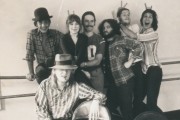 Please forgive me for my hyperbolic title, but I’ve made it clear in my reviews for films like Frankenstein’s Army that the found footage genre is my least favorite horror genre. That’s mainly because I haven’t seen much progression in the genre since The Blair Witch Project made the style so popular almost fifteen years ago. Most found footage filmmakers have recycled the same tricks, even those that are completely illogical. Nonetheless, I went into Willow Creek, a found footage horror film about Bigfoot, confident that writer/director Bobcat Goldthwait is the type of director who could do something unique in the genre. Though Goldthwait is new to horror, his previous comedies like God Bless America, World’s Greatest Dad, and Sleeping Dogs Lie are groundbreaking in their examination of social and moral taboos and are among the most shockingly hysterical black comedies ever made. But perhaps Willow Creek is Goldthwait’s greatest accomplishment in the sense that it is a found footage horror film that blows away anything else done in the genre over the last decade.
Please forgive me for my hyperbolic title, but I’ve made it clear in my reviews for films like Frankenstein’s Army that the found footage genre is my least favorite horror genre. That’s mainly because I haven’t seen much progression in the genre since The Blair Witch Project made the style so popular almost fifteen years ago. Most found footage filmmakers have recycled the same tricks, even those that are completely illogical. Nonetheless, I went into Willow Creek, a found footage horror film about Bigfoot, confident that writer/director Bobcat Goldthwait is the type of director who could do something unique in the genre. Though Goldthwait is new to horror, his previous comedies like God Bless America, World’s Greatest Dad, and Sleeping Dogs Lie are groundbreaking in their examination of social and moral taboos and are among the most shockingly hysterical black comedies ever made. But perhaps Willow Creek is Goldthwait’s greatest accomplishment in the sense that it is a found footage horror film that blows away anything else done in the genre over the last decade.
Jim (Bryce Johnson) is a Bigfoot fanatic who convinces his doubtful girlfriend Kelly (Alexie Gilmore) to come with him to the site of the famed Patterson-Gilmlin Bigfoot film, the famed 1967 footage of an unidentified creature purported to be Bigfoot. They decide to shoot their expedition as a home movie documentary. On their way they stop in Willow Creek, a small town in which the entire economy is based off Bigfoot novelty shops that Jim and Kelly find humorous. But as they approach Bluff Creek (where the 1967 film was shot), the pair has encounters that leads them to question not only the existence of Bigfoot but the nature of their relationship.
Roughly the first half-hour of the 77 minute film is a comedy and frequently hilarious. Jim and Kelly poke fun at the Bigfoot items that are all over Willow Creek, including an odd mural showing a tribe of the creatures helping humans farm and build houses (“Maybe he just doesn’t want to work and that’s why they can’t find him,” Jim says). This includes footage of actual locals of Willow Creek who are interviewed by Jim for the “documentary.” In most horror films (found footage or otherwise), the audience is given little reason to care about the stereotypical victims. In Willow Creek, this character development makes the characters more sympathetic and makes what eventually happens to them have all the more impact.
Unlike most found footage horror films, the audience gets the sense that this is really an amateur video because it features reshots of Jim’s “hosting” sequences, false starts, awkward pauses, terrible mic levels, mundane conversations — in other words, it’s so completely natural in its amateur-ism that it exposes how “artificial” other found footage movies tend to be because found footage filmmakers work too hard to make their films look amateur (as oxymoronic as that sounds). The entire film continues only 67 cuts, something that also adds to its “authentic” nature. But yes, it still suffers from “shaky cam” syndrome and can be jarring to watch despite its short length.
After an encounter with an angry local, the comedy abruptly stops and Willow Creek becomes a full-fledged horror movie. The genius of Willow Creek is the intense anticipation built by its suspense. There are scares, but not in the way found footage films have trained audiences for. The crown jewel of the film is one uninterrupted 19 minute shot of Jim and Kelly in their tent. The camera is entirely fixed on Jim and Kelly and their reactions, and much of the fear in this sequence is based on the unknown — particularly the sounds Jim and Kelly hear outside their tent. It is so ridiculously “cheap” in the sense that all found footage movies are, but it is absolutely genuine because Goldthwait makes it work with its slow burn and playing with the audience’s expectations of Oh my God, something is going to happen any moment now! … but doesn’t, like false dips on a carnival ride. The “telegraphs” of the scares are so unanticipated that I sat at the edge of my seat holding my breath so long I might have broken a world record. I can’t remember the last time a horror film made me feel that way in a theater.
I was surprised that Willow Creek isn’t simply a horror movie about Bigfoot, it’s a movie about Jim and Kelly’s relationship. Again, too many horror films neglect to try connecting the audience with its characters and end up relying on stereotypes and the actors’ good looks to make the audience sympathetic to their gruesome fates. Jim and Kelly seem like a real couple with issues outside of their amateur hunt for Bigfoot. While I’ve forgotten about nearly every character slashed to death or eaten by a monster in every horror movie I’ve seen, there were aspects of Jim and Kelly that I could personally connect with. What other filmmaker would think to put that element in a found footage horror film?
I absolutely loved Willow Creek and I really hope it becomes a watershed film for the found footage genre. In a sense I almost see it as Goldthwait throwing down the gauntlet to challenge filmmakers to grow the genre, not continue to rehash it. However, I honestly don’t know if Willow Creek can be topped by filmmakers more concerned about cheap scares than good stories.
RATING: Both hysterical and fearfully riveting, Willow Creek is the best found footage horror movie I’ve ever seen. (8.5/10).
We will have highlights from Bobcat Goldthwait’s post-screening Q&A session up soon!















Recent Comments